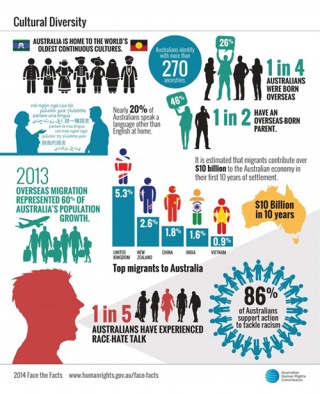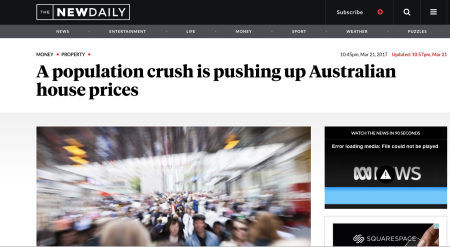Global cultural flow, a theory coined by Arjun Appadurai, demonstrated the definition and effects of cultural flows in 5 distinct scapes: ethnoscapes, technoscapes, financescapes, mediascapes and ideoscapes. Global cultural flow is a result of the process of globalization.
Ethnoscapes refer to the shifting landscape of people across culture and borders such as tourists, immigrants, refugees, exiles, guest workers. An example of ethnoscapes is Australia – a multi-ethnic country with one of the most linguistically and culturally diverse populations in the world. The data provided by Queensland Council of Social Services (QCOSS) reveals that immigrants and their offspring account for 40 percent of the Australian population. Economically speaking, migrants make a huge contribution to Australia’s economy as they made an estimated 10 billion dollars in their first ten years of settlement (Australian Human Rights Commission). Besides, international education industry contributed $21 billion to the Australian economy (Department of Education and Training 2016) and many graduates fill in the lack of highly qualified workers in engineering, accounting and much more.

On the other hand, immigration raises the unemployment rate in Australia as it causes native Australians to miss out on jobs that are taken up by immigrants. Besides, they are also responsible for pushing up house prices, scarcity of resources and environmental harm. Therefore, Australian government has to bring in policies to reduce the growth of immigration.

Technoscapes are the transmission of cultures through the flow of technology. New types of cultural interactions and exchanges are brought about by technology, particularly the Internet. The globally integrated information network has become a powerful tool in shaping how culture and communication are transmitted across the globe. Nowadays, it is extremely easy to access an online forum and hear an English man complaining about politics or watch a Brazilian dancing Samba. The Internet connects people across the globe without the matter of distance.
Financescapes refer to the global movement of money, including currency, trade and commodity. Countries nowadays are allowed to freely exchange good. However, it leads to the intensification of competition amongst corporations. Panos (2011) stated that “Corporations that previously have been enjoying the benefits of globalization, now face unstable and unpredictable demand and business opportunities and their products quickly become commodities, leaving them little or no pricing power and under constant pressure by new competitors that undermine profitability”.
Mediascapes refers to the electronic capabilities of production and dissemination of information through media. Ideoscapes are the global flow of ideologies. Mediascapes and ideoscapes have a close relationship as they usually work upon the reliance of the other scape. Ideas can be disseminated via media platforms. An example is Michael Jackson, famously known as the king of Pop. He used his fame to promote world peace, equality and human rights through his songs. These songs were then broadcasted on media and his ideology approached thousands of his fans around the world, which helped shape their perceptions and inspire them.
Appadurai’s five dimensional scapes are fluid and keep shifting, just as cultures do. Within each of these scapes, however, remains some disjunctures, but “the sheer speed, scale, and volume of each of these flows are now so great that the disjunctures have become central to the politics of global culture” (Appadurai, 1996)
Bibliography:
Appadurai, A 1996, Modernity at large: cultural dimensions of globalization, University of Minnesota Press, Minneapolis.
Ashley, MH 2010, Appadurai’s 5 -scapes, 15 September, Amherst College, viewed 9 August 2017, <https://www.amherst.edu/academiclife/departments/courses/1011F/MUSI/MUSI-04-1011F/blog/node/229354>.
Australian Human Rights Commission, Face the facts: Cultural Diversity, Australian Human Rights Commission, Australia.
Burgess, R 2017, A population crush is pushing up Australian house prices, image, 21 March, The New Daily, viewed 9 August 2017, <http://thenewdaily.com.au/money/property/2017/03/21/immigration-house-prices/>.
Community Door 2016, Work with diverse people, 3 November, Queensland Council of Social Service, Queensland Government, viewed 9 August 2017, <http://etraining.communitydoor.org.au/mod/page/view.php?id=283>.
Department of Education and Training 2016, Australia’s international education sector worth more than previously estimated, Department of Education and Training, Australia.
Edwin, V 2011, Michael Jackson – We Are The World (HQ), online video, Youtube, 21 Jun, viewed 9 August 2017, <https://www.youtube.com/watch?v=O6cE4DJUb_o>.
Panos, M 2011, The Good, The Bad, And The Ugly Side Of Globalization, 10 September, Forbes, viewed 9 August 2017, <https://www.forbes.com/sites/panosmourdoukoutas/2011/09/10/the-good-the-bad-and-the-ugly-side-of-globalization/#3f27a333483f>.
Williams, LS 1996, The effects of immigration on Australia: the research consensus as at May 1996, p. 1.
“immigration raises the unemployment rate in Australia as it causes native Australians to miss out on jobs that are taken up by immigrants”…REALLY?!!!! So Australians do sleep a lot…how bad.
Given that a whole year has now passed, since you have published your revision of Appadurai’s “scapes”, you should know by now, that immigrants also create more jobs and workplaces as they also happen to be consumers. So they would buy and thus, make people work around their needs for clothes, food, communication, leisure, etc, etc…And if Australians do “miss out on jobs that are taken up by immigrants”, is probably because immigrants happen to be more qualified or skilfull for that job, than the locals are.
Generally, immigrants have and accept very modest and underpaid jobs, that the locals would not normally accept or even, consider – in this case, the economy moves and works and the country’s GDP raises.
And the fact that the house prices have raised is really not a matter of immigrants – but it’s caused by a financial factor known by the name of real estate bubble. Really nothing to do with immigrants.
And finally, I really don’t understand your connection of immigrants with “the environmental harm”…This is a mystery to me, as may be to you too.
LikeLiked by 1 person
Pingback: Globalisation: The Global village and 5 scapes. – millie wood
Pingback: BCM111 Journal No.1 – That Uni Student
Pingback: [10/30] Thesis Proposal – Reverse Outline [1/3] – UnityCoin: Reunification Thesis Proposal
Pingback: Week 3. What would cultural studies’ scholars say? – Media Governance ICM835